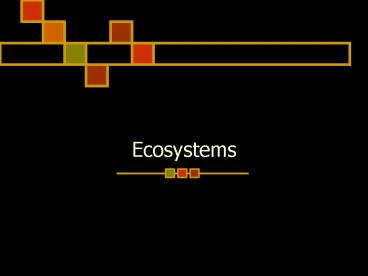Ecosystems - PowerPoint PPT Presentation
1 / 27
Title:
Ecosystems
Description:
Ecosystems Table of Contents 1. Process Skills 2. Cells 3. Classifying Animals 4. ECOSYSTEMS----- Make this the next clean page in your journal Ecosystem ... – PowerPoint PPT presentation
Number of Views:126
Avg rating:3.0/5.0
Title: Ecosystems
1
Ecosystems
2
Table of Contents
- 1. Process Skills
- 2. Cells
- 3. Classifying Animals
- 4. ECOSYSTEMS-------------------
- Make this the next clean page in your journal
3
Ecosystem
- Everything in the natural world is connected. An
ecosystem is a community of living and non-living
things that work together. Ecosystems have no
particular size. - An ecosystem can be as large as a desert or a
lake or as small as a tree or a puddle.
4
- If you have a terrarium, that is an artificial
ecosystem. The water, water temperature, plants,
animals, air, light and soil all work together.
If there isn't enough light or water or if the
soil doesn't have the right nutrients, the plants
will die. If the plants die, animals that depend
on them will die. If the animals that depend on
the plants die, any animals that depends on those
animals will die. Ecosystems in nature work the
same way. All the parts work together to make a
balanced system!
5
Parts and Pieces
- What are the major parts of an ecosystem?
- An ecosystem includes soil, atmosphere, heat and
light from the sun, water and living organisms.
6
The sun
- The heat and light from the sun are critical
parts of an ecosystem. The sun's heat helps water
evaporate and return to the atmosphere where it
is cycled back into water. The heat also keeps
plants and animals warm. Without light from the
sun there would be no photosynthesis and plants
wouldn't have the energy they need to make food.
7
Getting Down and Dirty
- Soil is a critical part of an ecosystem. It
provides important nutrients for the plants in an
ecosystem. It helps anchor the plants to keep
them in place. Soil absorbs and holds water for
plants and animals to use and provides a home for
lots of living organisms.
8
Water
- Without water there would be no life. Water is a
large percentage of the cells that make up all
living organisms. - In fact, you may have heard that humans can go
longer without food than they can without
water.. - It's true! Without water all life would die. In
addition to being an important part of cells,
water is also used by plants to carry and
distribute the nutrients they need to survive.
9
Atmosphere
- The atmosphere provides oxygen and carbon dioxide
for the plants and animals in an ecosystem. The
atmosphere is also part of the water cycle.
Without the complex interactions and elements in
the atmosphere, there would be no life at all!
10
Example
- In a lake ecosystem, the sun hits the water and
helps the algae grow. Algae produces oxygen for
animals like fish, and provides food for
microscopic animals. Small fish eat the
microscopic animals, absorb oxygen with their
gills and expel carbon dioxide, which plants then
use to grow. If the algae disappeared, everything
else would be impacted. Microscopic animals
wouldn't have enough food, fish wouldn't have
enough oxygen and plants would lose some of the
carbon dioxide they need to grow.
11
Living organisms within an ecosystem
- Ecosystems have lots of different living
organisms that interact with each other. The
living organisms in an ecosystem can be divided
into three categories producers, consumers and
decomposers. They are all important parts of an
ecosystem.
12
Individual- 1 specific organism
Population- all of 1 type of living organisms
Community Only the living factors
Ecosystem Living and non living factors
Biome Ocean
Biosphere Earth
13
Ecosystems
- Brainpop
14
Your task
- Create your own ecosystem organization triangle.
- Draw the items in the correct levels of the
triangle - Remember to color
15
Producers
- Producers are the green plants. They make their
own food. Consumers are animals and they get
their energy from the producers or from organisms
that eat producers.
16
Consumers
- There are three types of consumers herbivores
are animals that eat plants, carnivores are
animals that eat herbivores and sometimes other
carnivores and omnivores are animals that eat
plants and other animals.
17
Decomposers
- The third type of living organism in an ecosystem
are the decomposers. Decomposers are plants and
animals that break down dead plants and animals
into organic materials that go back into the
soil. Which is where we started!
18
Ecosystems
- An ecosystem is made up of all the living and
nonliving things that interact in one place. - Consumers depend on producers for food.
- Some consumers depend on other consumers.
- All organisms are dependent upon the other
organisms within an ecosystem to survive.
19
Energy and how it is obtained.
- It all starts with photosynthesis.
20
Remember
- Plants make their own food. This process is
called photosynthesis.
21
Where does photosynthesis occur?
- Photosynthesis occurs in the leaves of a plant.
22
What is needed for photosynthesis to occur?
- Light is needed for photosynthesis to occur. The
plants leaves use the light to make a sugar
called glucose.
23
Why do plants need glucose?
- Glucose is the food for the plant. It gives the
plant energy to grow.
24
How much glucose does a plant make?
- Plants make enough glucose to be used during the
night and on cloudy days when they dont get
sunlight. The extra glucose is stored in the
plants leaves and other parts.
25
How does photosynthesis help us?
- During the process of photosynthesis, oxygen is
produced. We use this oxygen to breathe.
26
(No Transcript)
27
(No Transcript)































